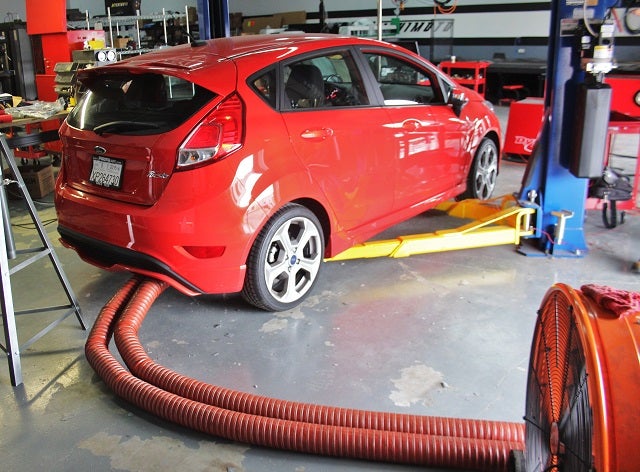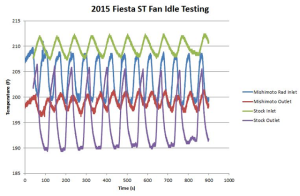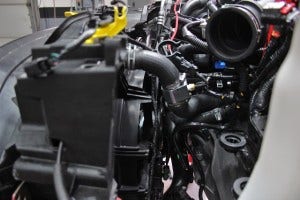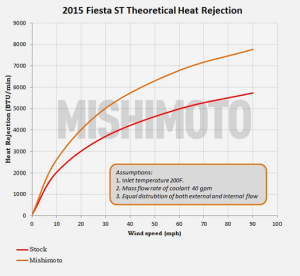
Keeping The Party Cool! Mishimoto's Ford Fiesta ST Radiator R&D, Part 5: Initial Testing Results
Interested in picking up our Fiesta ST aluminum radiator? Check out our the product page below.
Mishimoto 2014+ Ford Fiesta ST Aluminum Radiator
After quite an extensive developmental process, we're finally ready for some Ford Fiesta ST (FIST) radiator testing. This portion of our R&D process is crucial, as it will determine if our design is perfect or requires minor tweaks, or if the slate needs to be wiped clean for a fresh start. This particular radiator is unlike most that we develop. FIST owners are getting in trouble on the track, and no good solution to rising coolant temperatures has yet been found. We've attributed this to inefficiencies in both airflow and the inadequate stock FIST radiator. In order to fit a larger, more efficient radiator, we've had to modify the stock fan shroud. In doing so, we've created the space needed for the thicker radiator core, and we've managed to retain the stock fan. Check out the prototype.

Mishimoto Ford Fiesta radiator shroud assembly
Let's get to testing!
Idle Testing
With our design, we are modifying the function of the fan and shroud. This change will have an impact on at-speed cooling performance as well as idle cooling. All the known cooling issues with the FIST occur during track driving, so we know that the stock fan system is adequate for long-duration idling.
A fan shroud functions to pull air through the entire surface area of the core. It encloses the core, maximizing the efficiency of the electric fan. Below is a look at the stock shroud/fan assembly.

Stock Ford Fiesta ST radiator fan shroud assembly
With our shroud, this surface area has been cut in half. Our shroud is situated on the driver side of the radiator to provide clearance for the larger radiator.

Mishimoto Ford Fiesta radiator shroud assembly
Now, we are using the stock electric fan with our shroud, meaning it should produce high airflow. The only questionable factor is the amount of radiator surface area to be cooled by the fan. At speed, the additional airflow through the core should provide efficiency benefits.
We decided to conduct some idle testing with our setup against stock, to ensure that our Ford Fiesta radiator setup would not cause major increases in idle temperatures.
Testing Conditions
Ambient temperature: 70°F
Preparation: vehicle brought to operating temperature
Idle time: 15 minutes
Fluid: 100% distilled water
Sensors: temperature sensors in both inlet and outlet radiator hoses
Logging software: AEM AQ-1
Each setup was then tested for 15 minutes for accurate data collection.

Ford Fiesta ST radiator fan idle testing

Ford Fiesta ST radiator fan idle testing
Once complete, we organized our data in the plot shown below.

Ford Fiesta radiator fan idle testing
We have quite a lot of information going on here, so a simple chart should help put some numbers behind what we see in this plot.

Ford Fiesta radiator fan idle testing
We did expect the stock FIST radiator shroud to outperform our modified design in terms of idle airflow. Our intention with the test was to ensure that we could adequately cool the vehicle at idle with our design. From this initial test, it appears that the stock fan and control system are doing their jobs. We give this one the thumbs-up for street use. Higher ambient temperatures should produce similar results for efficiency and temperature reduction.
Idle Testing: Check!
Road Testing
At-speed driving is where we expect our radiator and shroud setup to shine. The massive, dense core paired to our free-flowing shroud should produce some nice temperature drops. To reduce variables in testing data, we will be conducting steady-state data collection for this first segment.
Testing Conditions
- Vehicle speed: 65 mph
- Starting fluid temperature: 190°F
- Fluid: 100% distilled water
- Logged distance: 4 miles
- Ambient temperature: 80°F
- Stock thermostat removed (allows radiator to drop temperatures without variable)
- Sensors: temperature sensors in both inlet and outlet radiator hoses
- Logging software: AEM AQ-1
Check out a couple shots of our sensors in place.

Ford Fiesta ST radiator testing sensors

Ford Fiesta ST radiator testing sensors
We made a run down the highway with each setup, which resulted in ideal data for comparison of efficiencies. Below is the plot from our logs!

Ford Fiesta radiator temperature data
The black lines represent the stock radiator, while the orange represent the Mishimoto counterpart. As you can see, we saw a decrease in both inlet and outlet coolant temperatures during this test, despite the lack of load on the system.

Ford Fiesta radiator heat rejection comparison
The results above assume gallons per minute (GPM) and inlet temperature data, but they provide a look at the potential of our improvements in efficiency. GPM data used is an average number for modern automotive combustion engines at cruising rpm. As you can see, the Mishimoto radiator shows far greater heat rejection, which continues to improve as airflow speeds increase. This means your at-speed track driving will see lower fluid temperatures with the improved radiator.
Road Testing: Check!
Additional (Track) Data
We've provided as much data as we can at the moment. Local temperatures have plummeted, with highs mostly in the 60s and 50s. These ambient temperatures will not provide the data we need to prove efficiency on the track. Once spring rolls around, we hope to hit the track with our shop vehicle for some additional data collection.
In the meantime, we have enough evidence to conclude that our design will provide improved heat transfer in any condition. Our team will be finalizing some last-minute touches on the design and will be working on an initial batch of production units.
Keep an eye out for more data and our discounted pre-sale details!
Thanks for reading!
-John











